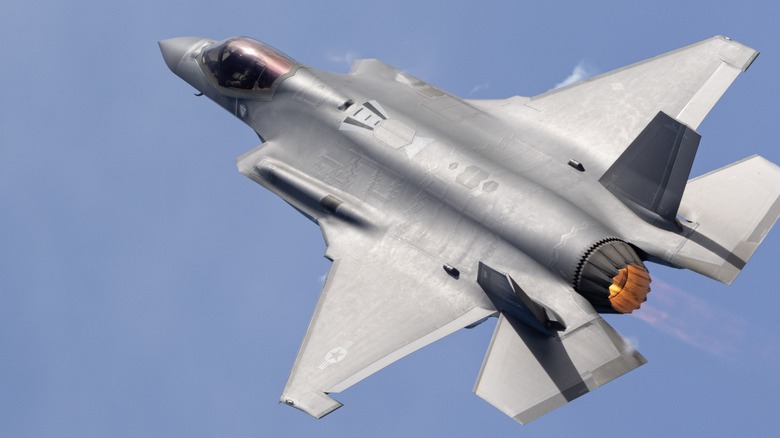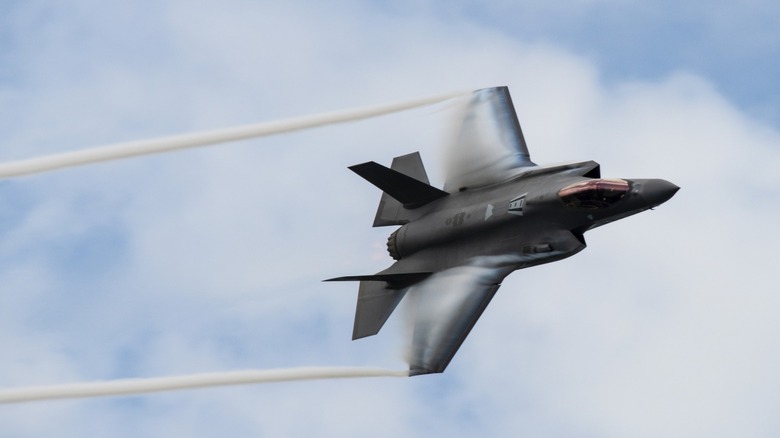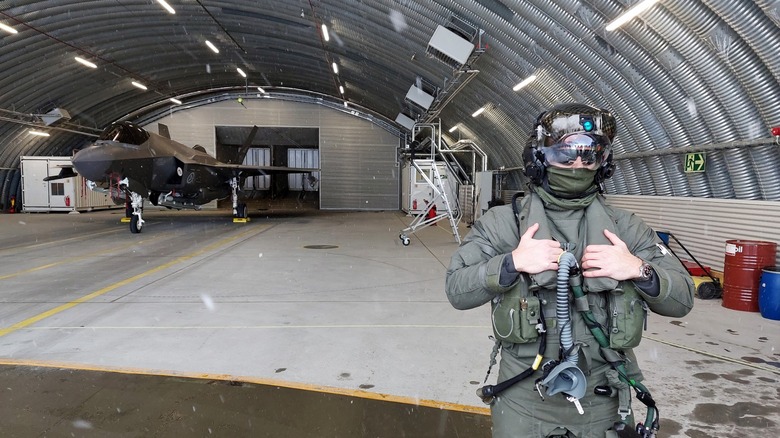How The Lighting Speed Of The F-35 Takes A Toll On Its Pilots
The Lockheed Martin F-35 Lighting II is a fifth-generation United States stealth fighter jet capable of reaching speeds of Mach 1.6 or 1,228 miles per hour. As one of the world's most advanced pieces of aviation technology, this supersonic jet can accelerate from .8 to 1.2 Mach in just eight seconds. In other words, the jet moves at supersonic speeds and can go from 610 to 920 mph in less time than it would take for you to tie your shoes.
While this innovative plane is a modern technological feat, it also has the unintended effect of putting a lot of stress on the pilots' bodies. According to an Insider interview, Monessa "Siren" Balzhiser, an F-35 test pilot for Lockheed Martin, said, "pilots come out looking like they are 100 years old."
Accelerating and decelerating at such high velocities puts a lot of pressure or G forces on the human body. Most people can withstand anywhere from 4G to 6G, but pilots often have to withstand up to 9G when accelerating and turning in the F-35. While pilots possess years of advanced training to prepare them for this, it doesn't make them impervious to the negative health effects.
Why are high Gs in the F-35 unhealthy?
G forces are a unit of measure that expresses force and acceleration or gravitational acceleration. 1G is the acceleration of an object toward the ground due to Earth's natural gravity. This unit multiplies when accelerating or decelerating at a high rate of speed, and extended exposure up to 6G could prove fatal. Gravitation forces are determined by body weight, so a person that weighs 150 pounds accelerating at 9G would have 1,350 additional pounds of force on their body, making it clear why piloting an F-35 puts strain on the body.
That said, it's not common for pilots to experience such high G forces for sustained periods outside of takeoff and strategic maneuvers. It's important to understand that one can travel at a high rate of speed without high G-forces and that the act of acceleration and deceleration creates additional force, not the velocity itself.
Acceleration and deceleration at high velocities are more likely to happen in dogfights with other jets. Immense G forces also occur when pilots are forced to eject from their jets. F-35 pilots undergo years of training to prepare to adjust to the additional gravitational forces, but it doesn't negate the toll it takes on their bodies.
How piloting the F-35 affects pilot's health
High G forces on the human body have both immediate and long-term health effects. High G forces result in blood pooling to the lower extremities, which causes a condition called Hypoxia, which essentially means that the body isn't getting enough oxygen. Eventually, this can lead to G-induced loss of consciousness or GLOC, in which the pilot loses consciousness and can't control the plane. Extended bouts of Hypoxia can also result in vision problems, speech difficulties, and impaired thinking. Years of specialized training and several countermeasures, including anti-G suits, are deployed to combat this.
A study published in the National Library of Medicine found that high G forces on the human body over a prolonged period have been shown to negatively affect the musculoskeletal system as well. According to the study, fighter pilots often experience strain in their cervical areas and upper backs. Pilots of high-speed jets have an increased chance of chronic neck and back pain, and the effects of high G forces have even been associated with decreased body height.
Additionally, between 2011 and 2017, more than a dozen F-35 pilots experienced oxygen deprivation symptoms, which were later found to be caused by lag time between the aircraft's life support systems due to irregularities between the mask and line pressure. While training and technology can help pilots withstand the immense G forces from piloting an F-35, it still clearly takes its toll on those flying the advanced aircraft.


